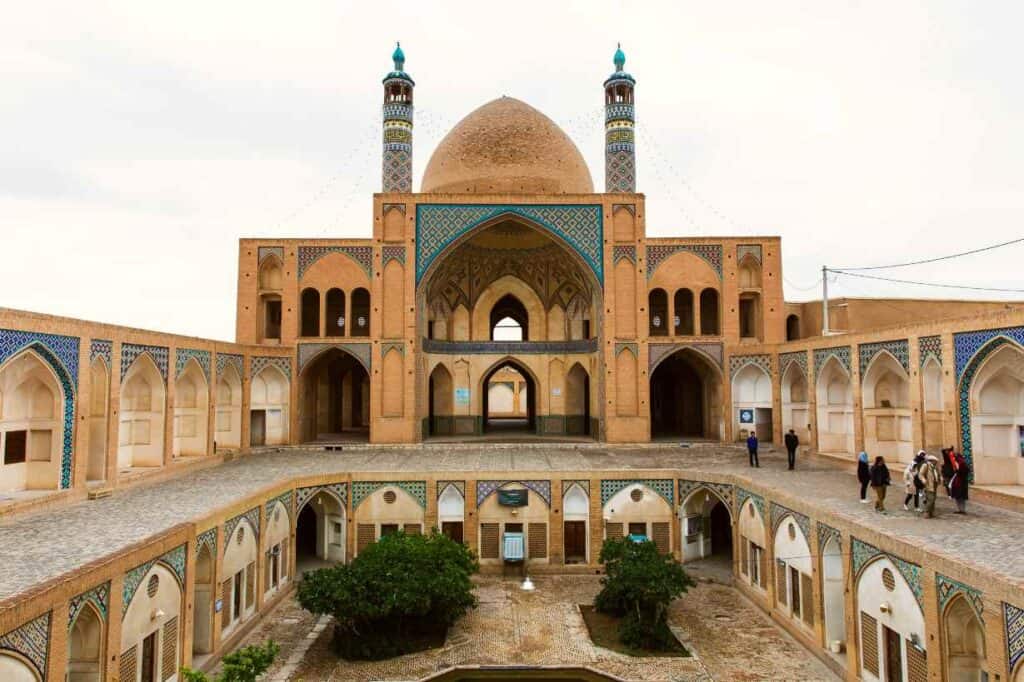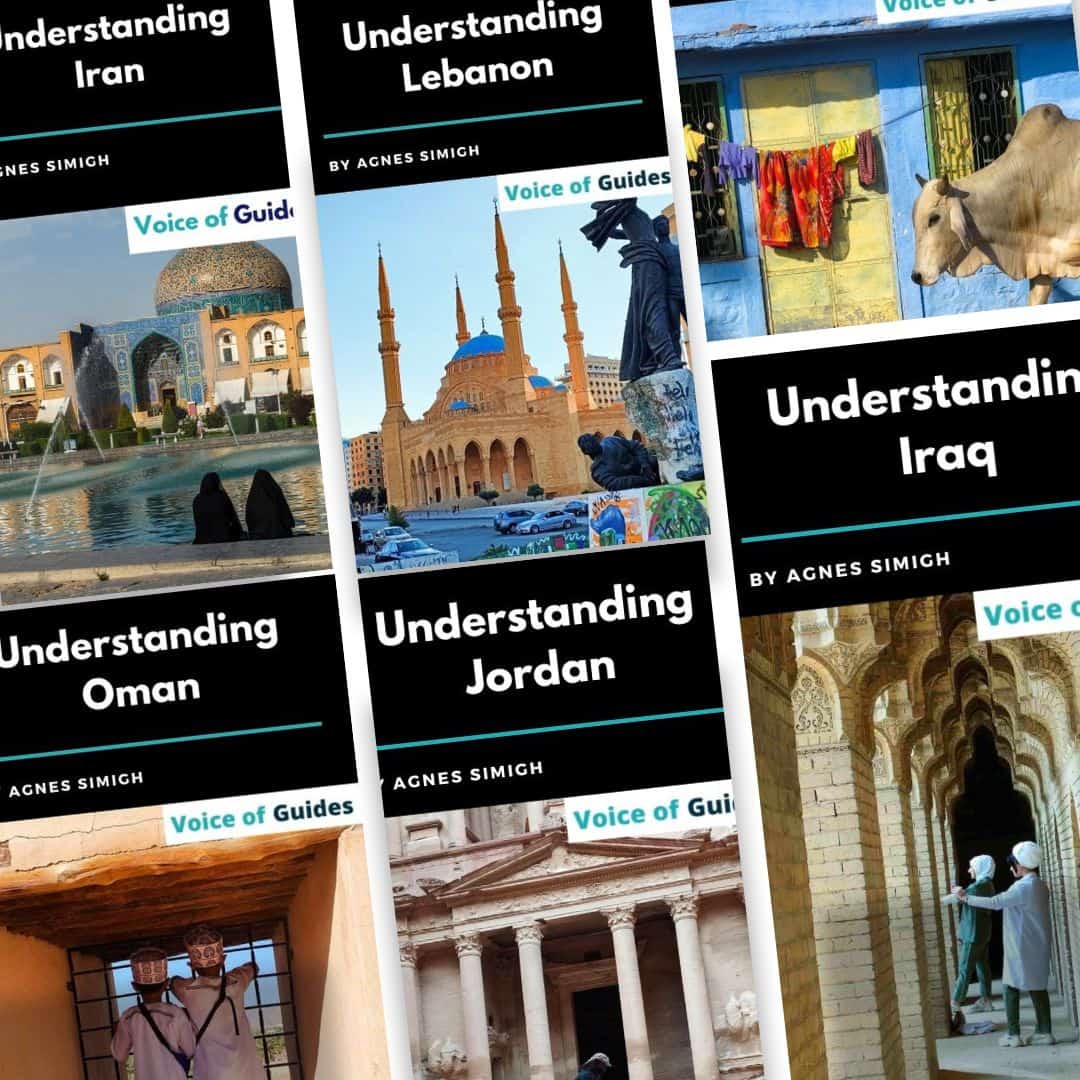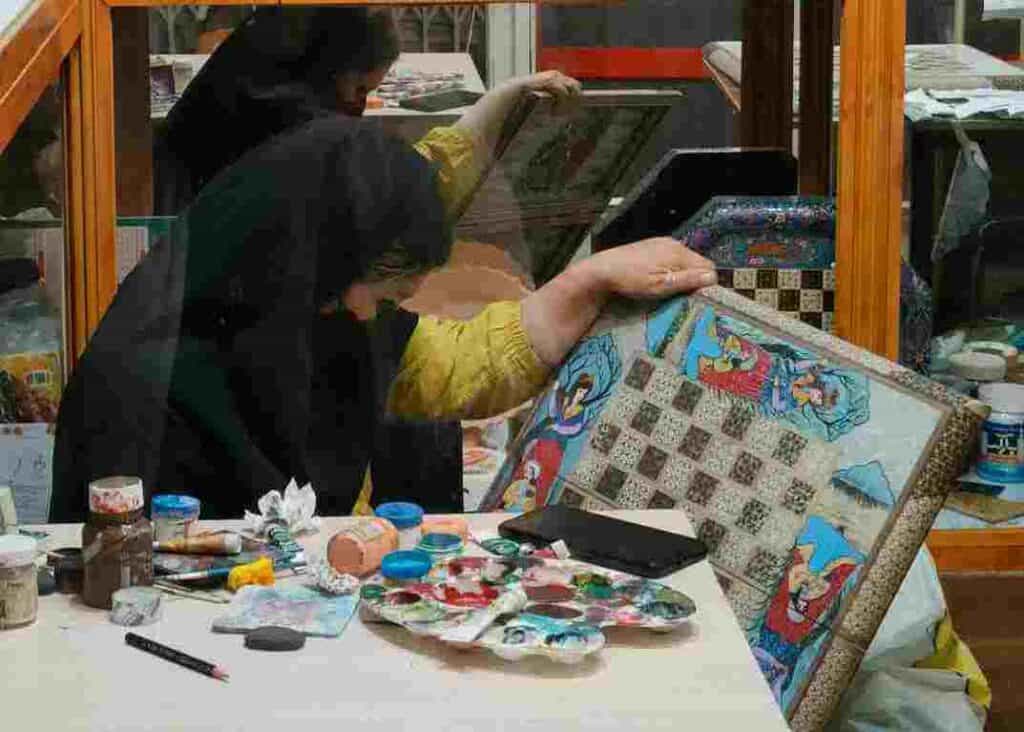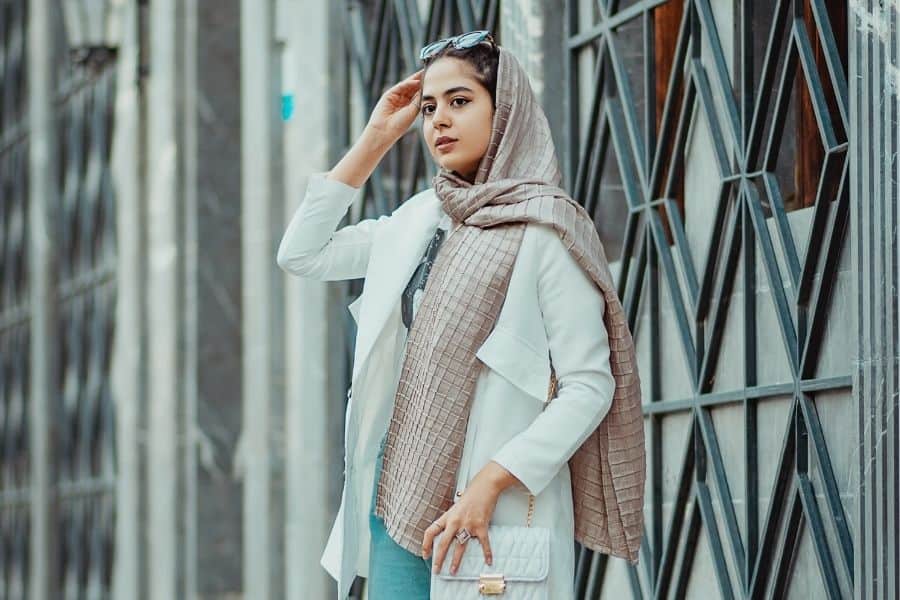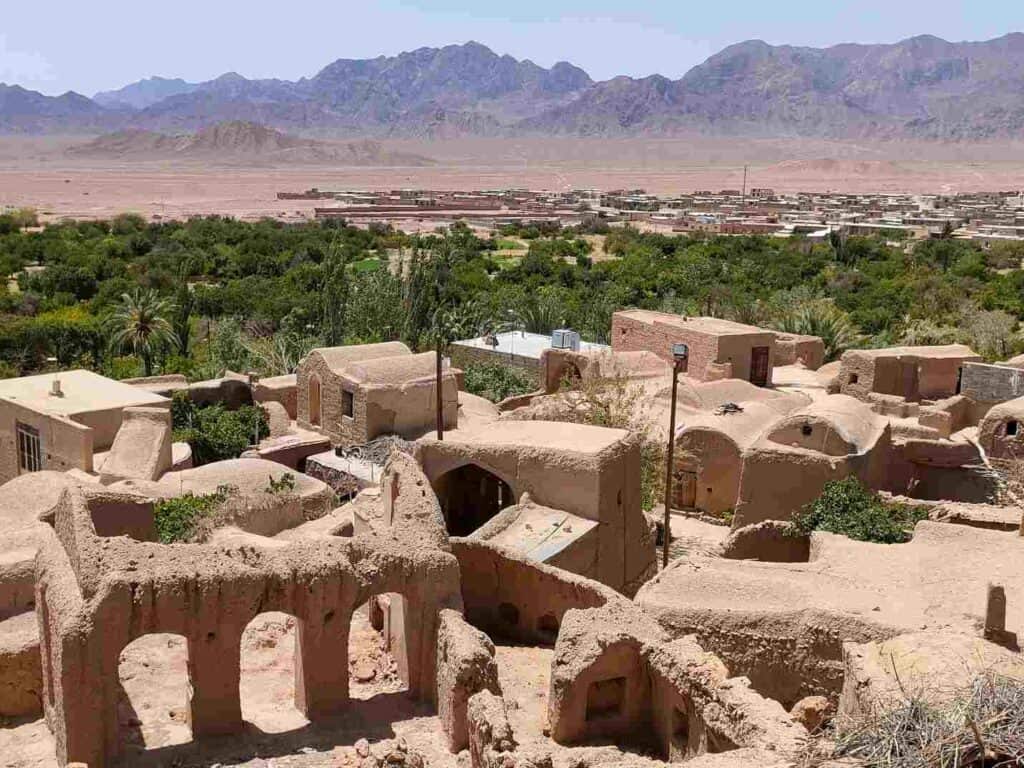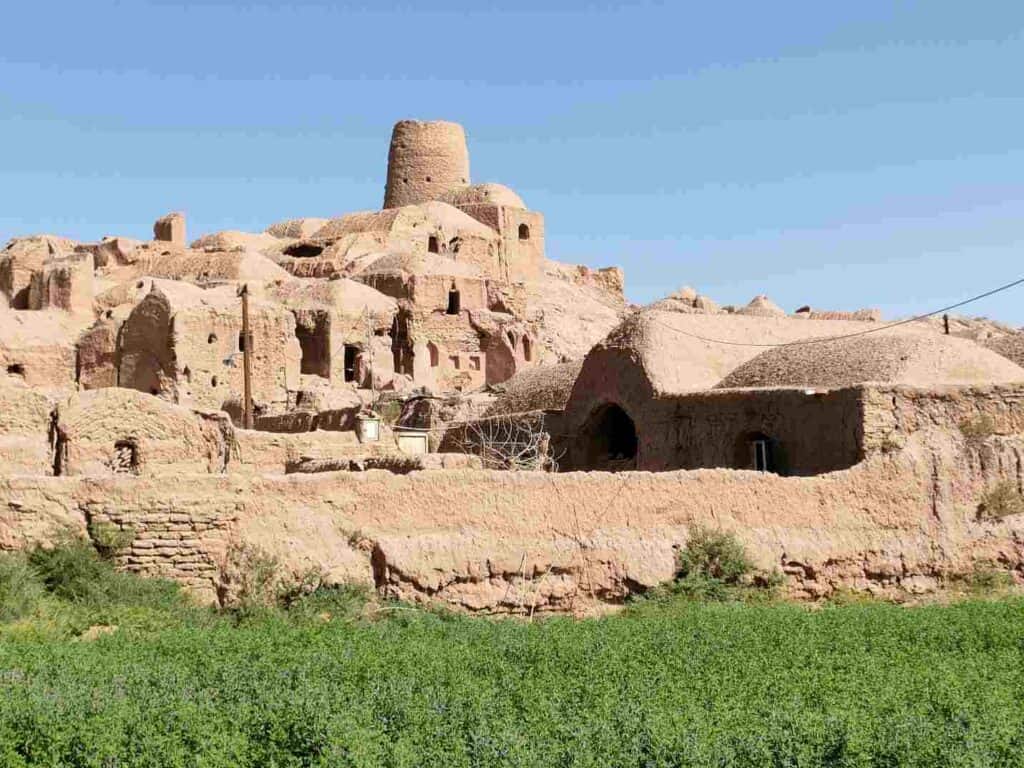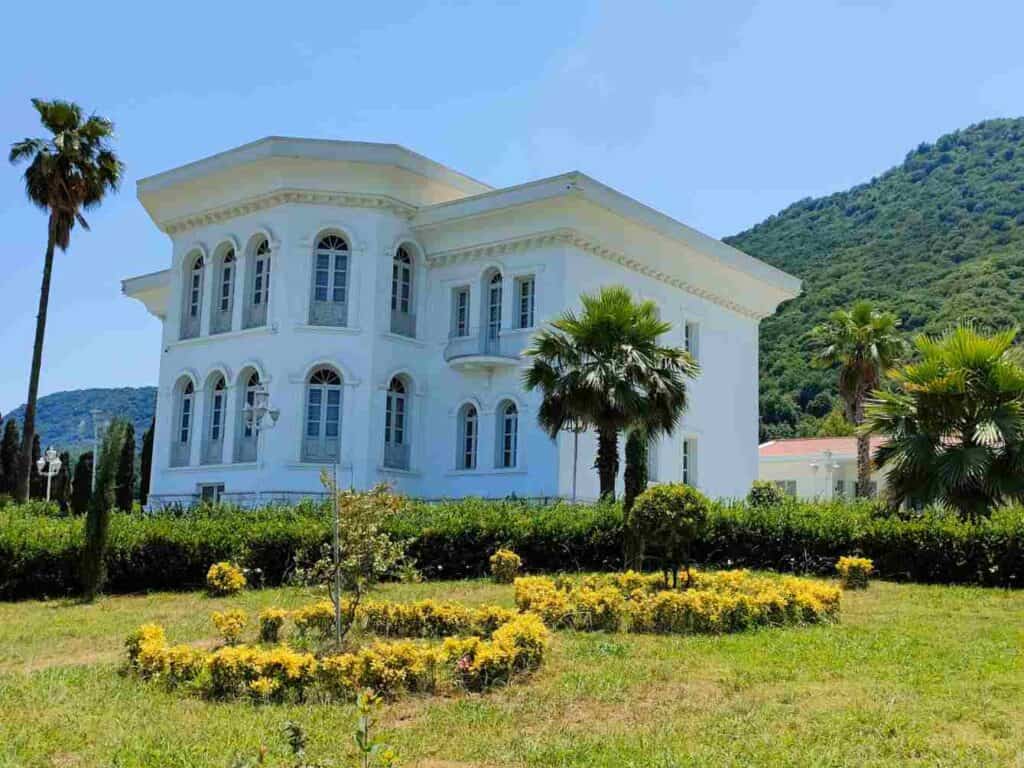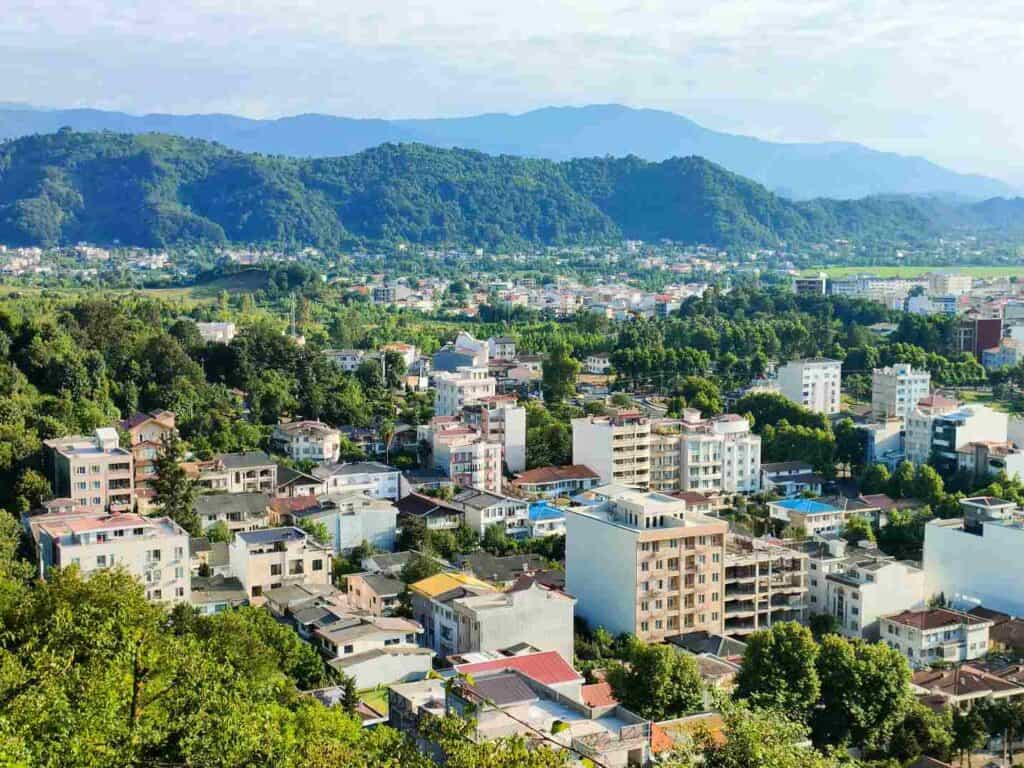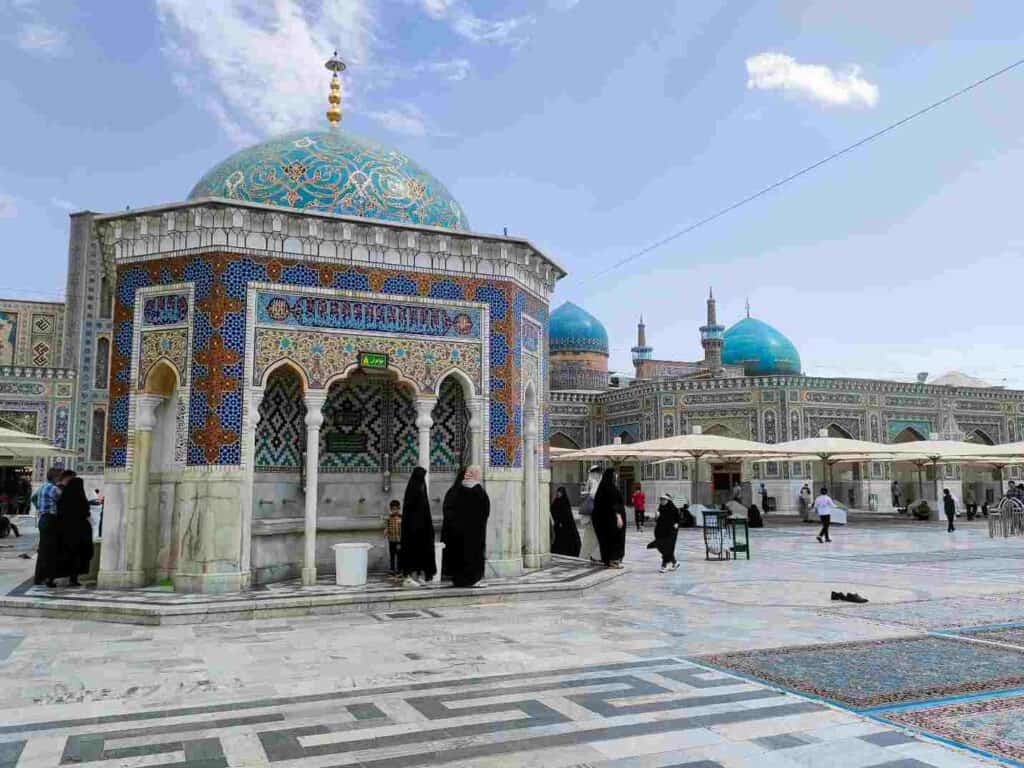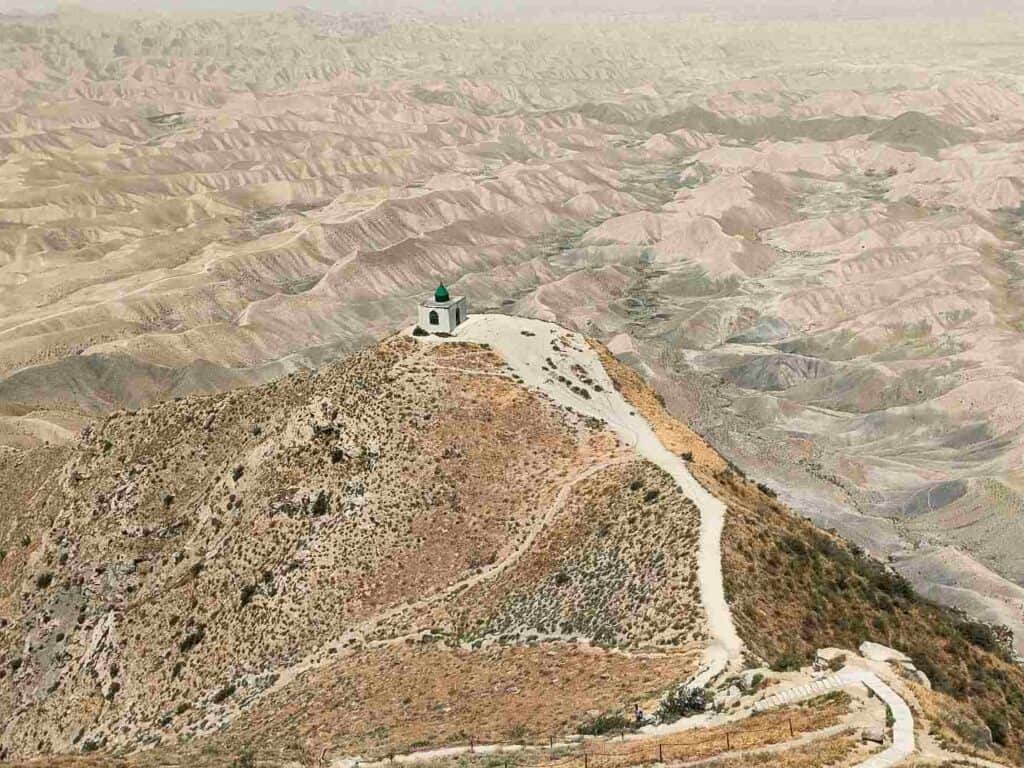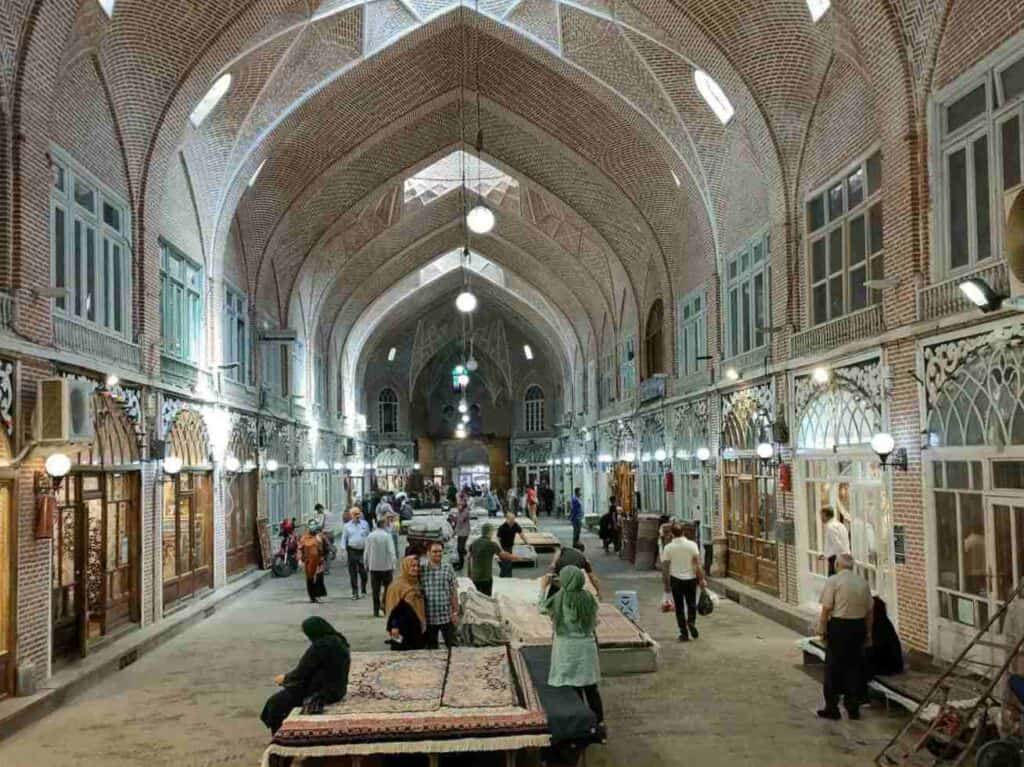This article may contain affiliate / compensated links. For full information, please see my disclaimer here.
Kashan, the quiet oasis city close to the Dasht-e-Kavir desert, is located along the highway to Isfahan. The architecture of the old town adjusts to the desert climate. Arches span over the winding streets, while high brick or clay walls provide shadow in the houses. The stunning historical private mansions are one of the highlights. You can cover most attractions simply on foot. If you come to Kashan between mid-May and mid-June, do not miss the Golabgiri rose festival nearby. Here you find a complete guide about the best places to visit and things to do in Kashan and around based on the suggestion of tour guides.
How to get from Tehran to Kashan?
Kashan lies along the Tehran-Qom-Esfahan-Shiraz highway 250 kilometers from Tehran. There are three ways to go from Tehran to Kashan.
By train: Buy your online ticket here: https://rail.cc/train/tehran-to-kashan
By bus: There are several daily buses, almost every half an hour from Tehran to Esfahan that pass by Kashan. However, many buses do not go to the city center but drop the passengers on the outskirts, from where you can continue with a shared or private taxi. Check your bus ticket here:
https://iran.1stquest.com/bus/tehran/kashan
Take a shared or private taxi: It costs approximately 3,000,000 IRR/ person. During the pandemic they only allow 3 people to share a taxi. This may change later.
Pin it for later!
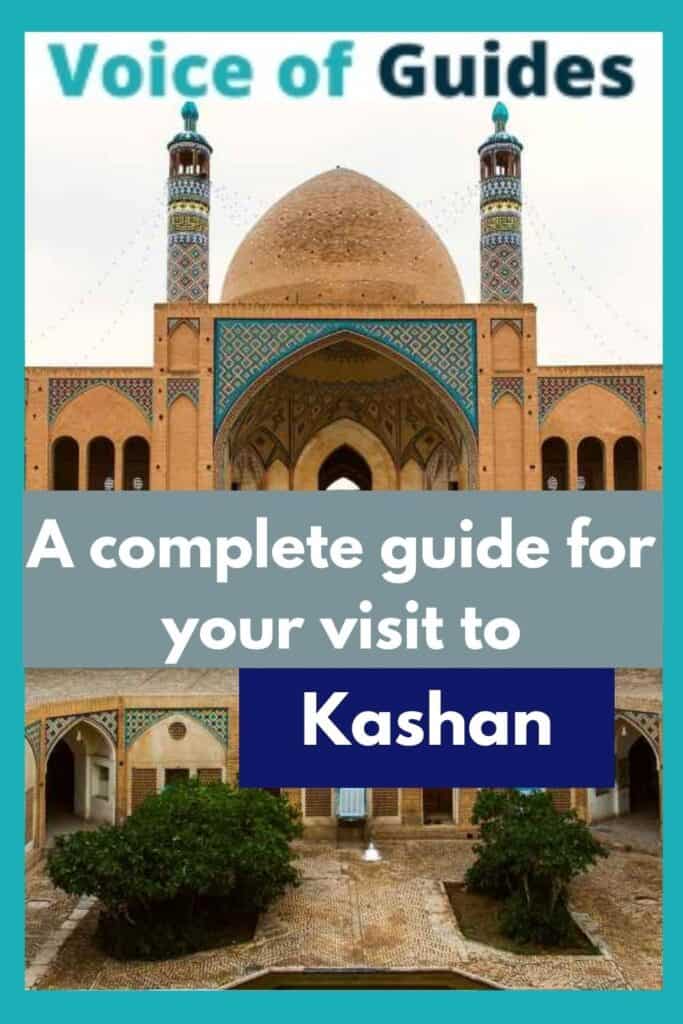
How to go from Qom to Kashan?
Go by bus: You can get on the Tehran-Esfahan bus that leaves almost every ½-hour. Kashan is another 113 km from Qom.
What you should visit in Kashan
Entrance fees: The below-listed entrance fees are from 2019 (before COVID times). By normal reopening, they are expected to change, but the exact prices are not known for the moment. Because of economic sanctions and the pandemic, prices of basic facilities and products tripled or quadrupled. It means that the entrance fees can significantly increase too.
1. Fin garden – one of the most famous Persian garden and UNESCO Heritage
Fin garden lies in the arid region of Kashan. It is said to be the oldest surviving Persian garden in Iran. It served as a recreational place for the famous Safavid ruler, Shah Abbas I, at the end of the 16th century. The nearby spring on a hillside is the water source of the Fin Garden. The water pressure suffices to operate the fountains, pools, and canals without mechanical pumps.
The orange trees, fruit trees, jasmine bushes, and flowers seem like a small paradise in the middle of the deserted landscape. The garden was extended and rebuilt during later periods. It includes bathhouses, a pool, and a recreational pavilion. The latter has a stunning domed ceiling decorated with paintings.
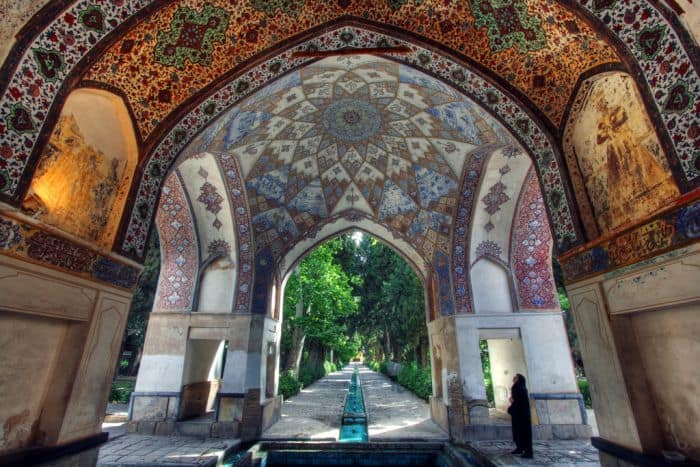
Persian gardens symbolize earthly paradise. They are usually rectangular, divided into four sections, decorated with trees, flowers, canals and fountains. In the center of the walled garden is a pavilion or a house.
Persian gardens are for physical and mental relaxation. According to Islamic belief, gardens symbolize the paradise mentioned in the Qur’an. Thus, the four heavenly rivers – milk, wine, honey, and water – must appear in the gardens as written in the Quran. The Persian gardens are unique because they have a meaning. The four quarters are called Chahar Bagh, or four gardens, symbols of the universe created by God. Water is the purification of men and women. Evergreen trees, especially cypresses, represent immortality. Besides, its cooling effect is practical in the hot desert climate.
Opening hours: 09:00 – 16:00
Entrance fee: 200,000 Rials
Location: The garden is not in the center but some kilometers away. Grabbing a cab is the best option.
2. Tabatabai House
It is a beautiful example of a wealthy merchant’s residence from the end of the 19th century with inner courtyards and a labyrinth of 40 rooms. The underground rooms were pleasant during the summer heat, while the wind catchers combined with the canals worked as air-conditioning.
The high walls provided shadow, and as required by the Islamic traditions, they also ensure the privacy of the residents. Behind the defensive walls, there are small paradises.
In general, a merchant’s house looks simple from the outside and has stunning interior decoration. Kashan is close to the desert. Since the region lacks wood, stucco has become a common material for interior decoration that gave an elegant look at the same time.
Opening hours: 09:00 – 17:00
Entrance fee: 200,000 Rials
3. Borujerdiha House
The Borujerdiha House is another mansion that belonged to a respectful merchant. It took 18 years to complete it and it became one of the most outstanding properties in Kashan. Seyyed Mehdi Borujerdi equipped it with an inner courtyard, pools, and nicely decorated rooms. All that just because he fell in love with a girl from the affluent Tabatabai house and sought to impress the family. The same architect designed this building as the Tabatabai House.
Opening hours: 09:00 – 17:00
Entrance fee: 200,000 Rials
4. Abbasi House
If you are fond of these typical wealthy mansions, you can also visit the Abbasi house. Despite being decorated with mirrors, stained glasses, and lattices, it is much simpler compared to other traditional homes of Kashan.
Opening hours: 09:00 – 18:00
Entrance fee: 150,000 Rials
5. Sultan Amir Ahmad Bathhouse
It is a traditional Iranian public bathhouse from the Safavid era in the 16th century. The bathhouse contains several pools and small rooms decorated with colorful, mainly turquoise, and golden tiles. Climb up to the roof made up of multiple domes with several glass inlays. It provided lighting in the bathhouse but concealed it from the outside.
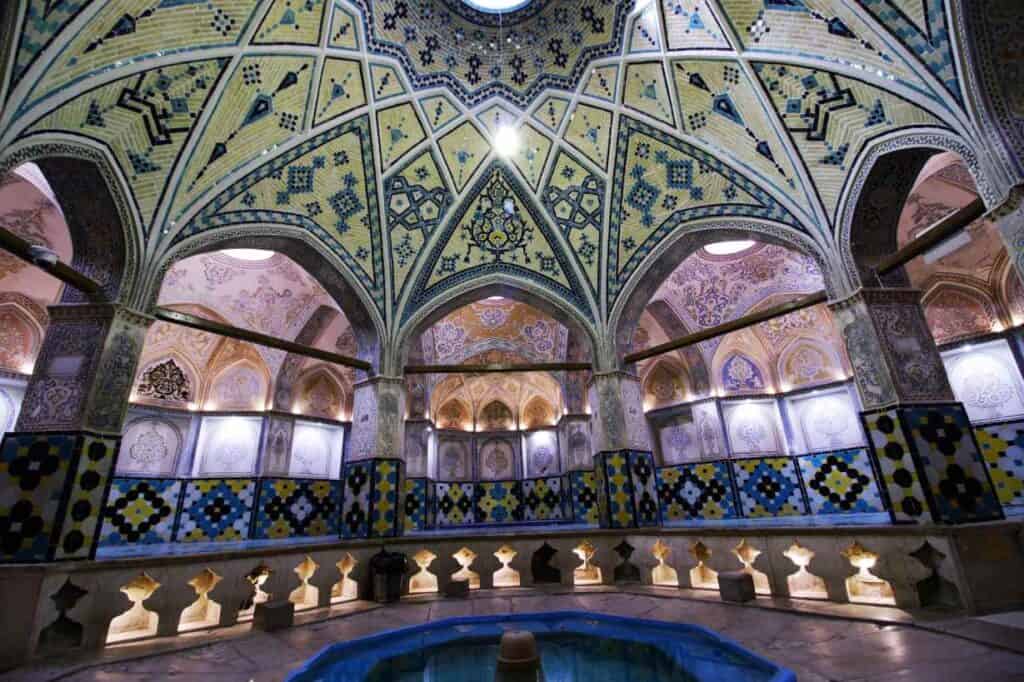
Opening hours: 09:00 – 17:00
Entrance fee: 150,000 Rials
6. The Agha Bozorg mosque – what you must visit in Kashan
The Aqha Bozorg Mosque is a beautiful symmetrical complex serving religious and educational purposes (Madrasah) in Kashan. It is unique that the entire complex, including the dome, is made of brick.
It consists of both above-ground and below-ground structures. When you enter the mosque, you see that it has two levels with a central courtyard. The small porches around the ground floor were ideal places for the theological students and devotees to relax in the hot summer. The chambers below were classrooms.
The basement has a unique element, an ancient refrigerator called Yakchal. A large pit covered with mud and straw was essential in the desert climate. The fridge kept the ice in winter times and served as food storage in the summer.
Agha Bozorg, his father and his sons were prominent Islamic scholars, leaders of the Shiite community and enjoyed a great reputation.
Restrictions: Women get an abaya at the entrance to cover their head and body.
7. Visit Kashan during the Golabgiri Festival when they harvest the famous Iranian rose water
Between mid-May and mid-June, fragrant rose farms are blooming in various shades of pink around Kashan city. It is almost unbelievable that all the rose bushes ready to be harvested are located in the Iranian desert. If you arrive in Iran during blossoming, make sure to visit Qamsar, Niasar, Barzak, or Ozvar. These otherwise sleepy towns get tons of Iranian visitors at this time of the year. They come to watch locals harvest the rose petals and make rose water and rose oil from them. And it is said to have a tradition of 2,500 years in Persia. The famous Golabgiri Rose Festival takes place in several towns in Iran, but the one in Kashan is the most spectacular. It is a rather spontaneous gathering that is inseparable from the Persian culture. You are most welcome to have a closer look at the rose petals piled up in front of the houses. The owners happily explain the story of the rose water making step by step.
Rose harvesting in Kashan
Each rose farm is located at a different height so that the blossoming and harvesting times also vary. They begin to collect the rose petals well before sunrise because the warm sun rays take away their aroma. Women dressed in traditional colorful clothes fill their skirts, and men fill their baskets with rose petals while happily singing. Take the stem with your right hand and the flower with your left hand – that is the rule.
The rose petals piled up at the house must be processed immediately after harvest. They put twenty kilograms of fresh rose petals into a 120-liter capacity copper pot. It takes a lot of experience and sense to find the right proportion of water and the right time to take the petals out of the cauldron. They place the cauldron on a traditional stove made of stone, brick, and clay. Then they seal it with a clay pot.
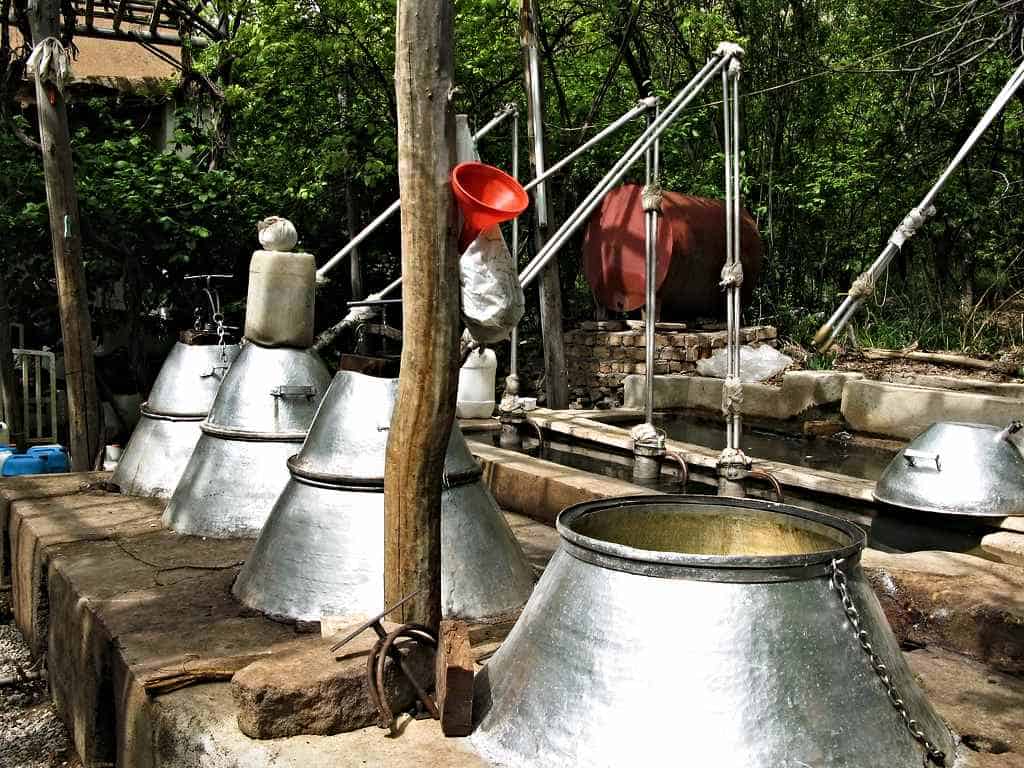
The steam dissolves the fragrance from the petals, which reaches the copper pitcher that stands in a basin filled with cold water through a tube attached to the copper pot. The steam gradually cools down. After a while, the liquid clears, and a thick layer of rose oil forms on its surface. One hundred kilograms of rose petals produce eighty liters of rose water and a thimbleful of rose oil. The whole distillation process takes about 4 hours.
Many people still choose the traditional method instead of the mechanized solution because it will result in a better quality. Locals are very proud of their traditional activity. Even the most sacred place of the Islamic religion, the Kaaba Stone of Mecca is ritually washed every year with rose water from Qamsar.
How do the Persians use rosewater?
Most families make their living by producing rose water from the Mohammadi, also known as Damask rose. It is one of the most famous varieties of roses in the world.
The Persian rose water has a worldwide reputation. They use it for religious ceremonies, perfumes, and as traditional medicine. They wash graves of family members and some religious persons with the rose water. It has a beneficial effect on heart and skin problems and indigestion. Besides, it has a calming effect, heals depression, grief and stress. Rosewater also helps if you have a throat ache or headache.
Everybody likes the scent of roses. But in Iran, rose oil is not only perfume and traditional medicine, but Persians use it for cooking. In hot weather, rose juice is a popular soft drink. Put four to six spoons of rosewater, sugar, or honey and a handful of black mustard seeds in a liter of ice-cold water. Some Persian biscuits contain some rose water, and one of the most famous Persian traditional ice creams, Faloodeh, can also have a rosewater topping. You can even add it to tea and coffee. Iran is the largest producer and exporter of rose water and oil. Still, they sell most of them locally. There is no other place where they use it in so many ways.
Gol Ghaltan, literally “rolling in flowers”: an old ritual with rose petals
They bathe the less than one-year-old babies early morning and then lay them on a white sheet covered with rose petals. Four family members hold the sheet by each corner while singing religious songs. Of course, they carefully remove all leaves and thorns before. In the northern province of Semnan, this lovely tradition exists for 400 years, which they say will protect the child from diseases, strengthen his immune system and make him a happy natured person.
Recommended tours from Kashan
Go on a desert trip – one of the best things to do in Kashan
Since Kashan lies next to the Maranjab desert (part of the larger Dasht-e-Kavir desert), it is a perfect place to go on a desert trip. Visit the almost 2000 years old underground city, Noushabad, the salt lakes, and watch the changing colors of the dunes by sunset. After that, you can enjoy your dinner in a traditional Caravanserai and return to Kashan.
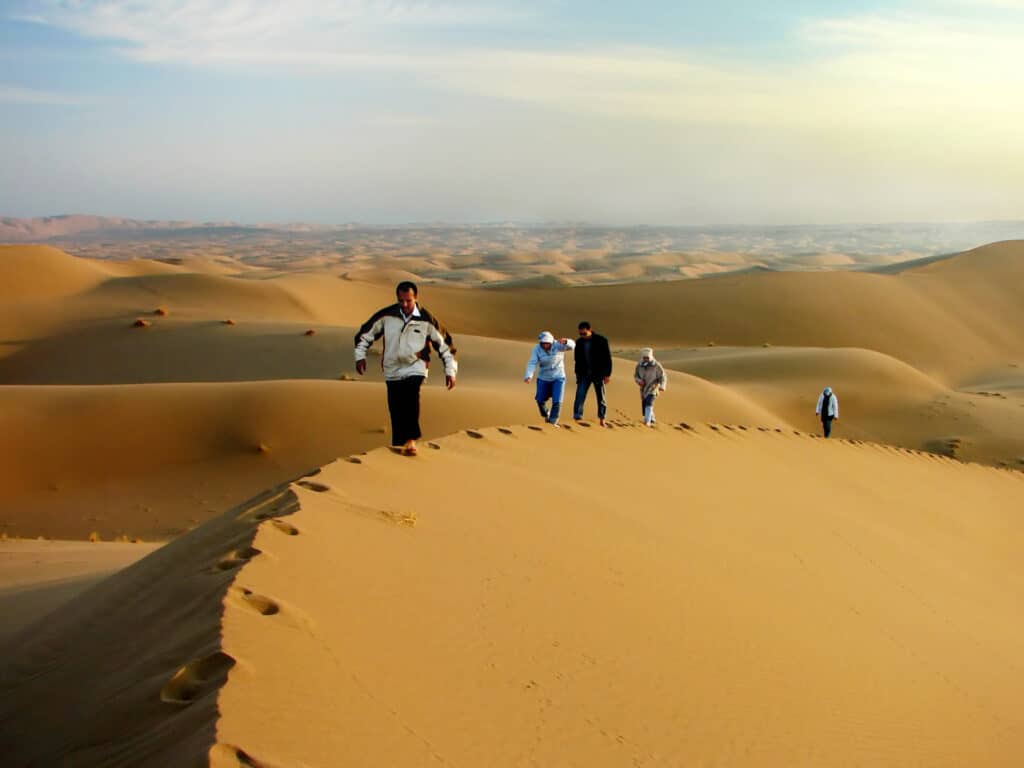
Visit Abyaneh, the red village on a day trip from Kashan
Abiyaneh, also known as the “red village” called after the color of the mud-brick houses. They have ancient wooden doors and knockers. The village has a similar structure to Masuleh and Palangan but does not cling so steeply to the side of the mountain and has wider roads as well. Abyaneh is unique because locals still speak a Middle Persian language that even other Iranians do not understand. It is one of the most stunning villages in Iran.
Tip: Dress up in local folk costume, hire a local tour guide to tell the story of each house, knockers, memorials, and shrines. Be prepared that Abyaneh is one of the busiest tourist destinations in Iran. Especially during Nowruz, many locals come for a visit.
Book your trip from Kashan to Abyaneh
Where to sleep in Kashan
Sana Historical Hostel (1-star)
Traditional residence of Noghli house (Address: No. 20, Ab Anbar Khan Pass, Pamanar Alley, Mullah Habibollah Sharifi St., Kamal Al-Molk Square, Kashan)
Manouchehri traditional residence (Address: No. 7, Sabet Alley, Mohtasham Kashani St.)
Negarestan hotel (3 stars) (Address: Amir Kabir St., Kashan)
Safa Historical Guest House (2-stars)
The traditional residence of the Ameriha House (Address: 7th dead end, Alavi St., Kashan)
Matin Abad Eco Camp: A unique place to spend a night in the desert 60 kilometers from Kashan. The eco-resort hosts the guests in simple rooms designed in a Caravanserai-style building, tents, and Iranian village-style rooms. They offer plenty of activities, from camel riding to short jeep safaris, and you enjoy sleeping in the desert.
How to plan your trip to Iran
Book your flight to Iran: I always use Google Flights, Skyscanner or Wayaway to find the cheapest flight tickets worldwide. To get an extra 10% for your Wayaway Membership Plus program use my discount code VOG
Important: Booking.com and other common platforms do not work due to international restrictions in Iran. The only exemption is Skyscanner, where you can book both your international flight and accommodation in Iran!
Book your accommodation in Iran: Hostelworld.com offers a limited number of hostels. All other services are only available through local travel agencies, like 1st Quest.
Get your visa to Iran: 1st Quest or Tap Persia local companies can easily arrange your insurance for Iran
Book domestic flights, hotels, transfers, bus and train tickets, and local tours, all in one place via 1st Quest travel agency.
Another good thing is that by using my discount code, you get an extra 5% off your bookings: VOG%1stQ
Virtual Private Network (VPN): Use VPNExpress, the fastest and best Virtual Private Network to get access to blocked sites in Iran and to prevent hackers from stealing your private information.
Insurance to Iran: 1st Quest or Tap Persia local companies can arrange for you visa to Iran
Book local guides and local tours: Pirsik is specialized in offering tour guides and local tours in less touristic countries, including Iran.
Recommended Restaurants in Kashan
Ameriha Historic House Restaurant (Address: 7th dead end, Alavi St., Kashan)
Melal Restaurant (Address: 16th Zoufaqar Alley, Amir Al-Momenin St., Kashan)
Khatoon Restaurant (Address: 22 Bahman St., Kashan)
I hope that the above guide was useful for your visit to Kashan.
Kashan’s serenity is a refreshing contrast to chaotic Tehran. The private mansions, hammam, mosques, and bazaar are definitely worth a visit. If you travel to Iran during the time of rose harvest (between mid-May and mid-June) the rose festival will be a top cultural travel experience.

